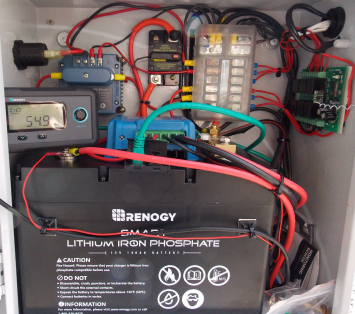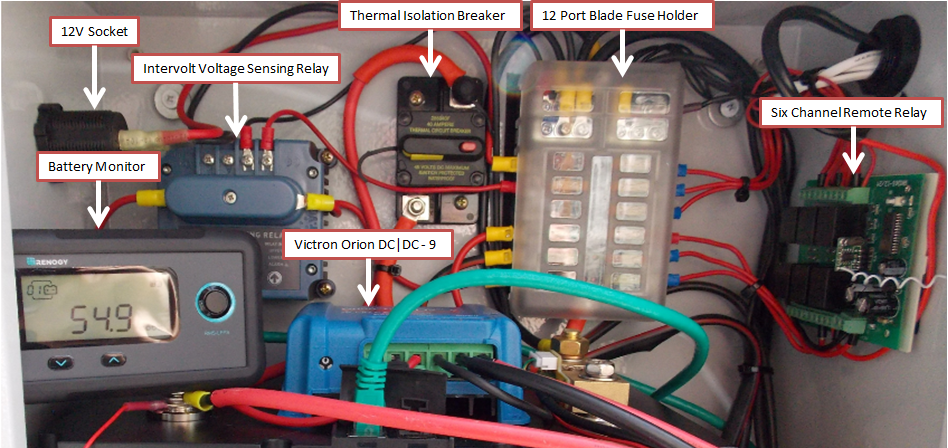Blog

Lithium Iron Phosphate (LIFEPO4) batteries are exceptionally good batteries and we have been putting them through their paces. This is how we are giving them a good work out in all conditions.
Our Lithium Iron Phosphate Testing System
With the price of LIFEPO4 batteries coming down a lot we decided to invest in a Renogy 100ah Smart battery that was newly released many months ago. After a lot of research on the various types this particular battery stood out from a lot of the others. What made it particularly attractive was the quality of build, the cycle life and the extremely good BMS (battery management system). We like Renogy gear and do recommend them as all of the various Renogy components we have purchased have been excellent and very affordable including their LIFEPO4 batteries. To test this new battery type we installed a steel electrical enclosure into our outdoor area and fitted the battery along with all its sundry components which we will explain what they do. The main goal was to feed energy from this small test system into our main house battery electrical system. It is important to understand our house battery system is made up of two banks of 6 x 2V 790ah Lead Acid Gel batteries connected in parallel. Why this is important is because you must NEVER mix these different chemistry types. They have very different charging characteristics and hence must be isolated from each other.
So if the two different types must be isolated you may ask: how do you supply energy from one type into the circuit of the other type?
The answer to this is in the design of the cabinet and how it charges and discharges to back feed into our house battery system. This is a good way to increase your system capacity if you do not want to invest in more batteries of the same chemistry such as lead acid. It is important to understand all the various settings and configuration of the various parts are not an exact science and do require a degree of experience through observation.
Charging
The LIFEPO4 battery in the cabinet is charged via our test/demo wind turbine tower that has a 160 Watt Renogy Panel connected to a Renogy Rover MPPT charge controller. Additionally we have one of our budget DB-400 Wind Turbines also supplying wind power. This setup can easily put out 70ah or more per day to charge the battery back up to full capacity. On a windy and sunny day generally the battery is fully charged by midday. The charging of this battery is completely independent from the charging system of the house Lead Acid Gel batteries. If you connected a LIFEPO4 battery in with Lead Acid you will destroy it very quickly. The tower connects via a 16mm2 twin core DC rated cable using standard 50 amp Anderson plugs. This threads through a gland in the base of the enclosure to a thermal isolation breaker for safety.
Isolation
The way you can isolate the supply of energy from dissimilar battery chemistry types is to use what is known as a fully isolated DC to DC converter/charger. In this case we have used a Victron Orion 12 | 12 - 9 DC to DC converter. These converters come in various sizes and voltages. The Orion converter we are using can supply up to 110 Watts (9 amps). This essentially provides fully voltage regulated output from our LIFEPO4 battery to our main house battery electrical system. You can control the output voltage from the Victron Orion via a small potentiometer. This is very important as we will explain shortly. The important thing to remember is voltage is just like water pressure. If one source of energy has a higher voltage than another source then energy will be consumed more readily from the source with the higher voltage.
Supply
The way we can supply up to 110 Watts into our house battery system is by setting the output of the Victron DC to DC converter to a higher voltage than the voltage of the Lead Acid batteries. The output of the Victron Orion is connected back into our house battery electrical system and fused independently (15 amp blade fuse). To set the output voltage of the Victron Orion correctly we measure the voltage of that output circuit to identify any voltage drop. We then set the output voltage of our Victron Orion accordingly and in this case it is set to 13.1V. This sometimes may need adjusting up or down and can be done by simple observation as to how it is behaving over time.
So this is what happens when the sun goes down:
Once our house lead acid batteries are no longer receiving enough power to hold them at float (13.6V) or a voltage that is higher than the output voltage or the Orion Victron the LIFEPO4 will start back-feeding energy into the house battery electrical system. This is simply caused by the differing voltage levels. The Victron Orion will gradually supply more and more power as the house battery system voltage decreases with a limit of 110 Watts available. Typically we see a maximum draw of 90 Watts from the LIFEPO4 through the Victron Orion which is a nice amount to draw from a battery of this size. Generally this will supply energy for about eight hours (give or take).
So this is what happens when the sun comes up:
The solar array that feeds our lead acid house batteries starts supplying power and the battery voltage rises steadily. As soon as it exceeds the voltage of the Victron Orion output essentially no more power will be supplied out of the LIFEPO4 battery and it will start its own charging from its source.
The next important thing to take into consideration is not draining the LIFEPO4 battery until the BMS cuts you off. Whilst not a problem it will reduce the life of your LIFEPO4 battery if you discharge it so heavily.
Control
It is very important to not over discharge any battery including LIFEPO4. We like to take no more than 80% of the available capacity and in the case of our test system it will take roughly 70% of the available capacity (70ah). Managing this cutoff is done via a piece of hardware called a programmable voltage sensing relay. The best relay and the only one we would ever recommend or use is the Intervolt 150 Amp solid state relay. Essentially what you do put the relay between the battery and the Victron Orion input then set the disconnect voltage and a connect voltage on the relay. This will connect and disconnect the LIFEPO4 battery from the Victron Orion safely. All battery types will have a voltage discharge curve Vs state of charge. In the case of our LIFEPO4 battery the disconnect voltage is 12.9V. The reconnect voltage is set to 14.1V. This essentially translates roughly to a 70% capacity use before disconnecting and around 90% state of charge before reconnecting.
Generally with no wind turbine power overnight this system will disconnect itself at around 4am. If we receive windy nights then the system will continue to remain connected for many days at a time. This of course is all dependent on numerous factors like how much power we consume from the house battery system, the time of year (sun hours) and if its windy or not.
Monitoring
The last thing that is a must have for any battery system is a good battery monitoring system. In the case of our Renogy LIFEPO4 we have a Renogy battery monitor that connects directly to the battery BMS. This is a 100% accurate Voltage, State of Charge and Amp Meter. Using the battery monitor the whole system can be tweaked for maximum performance.

If you are looking at setting up your own battery system but aren't sure what you need why not contact us? We can provide a consultation service to get you on the right track.
Comments
- No comments found
Leave your comments